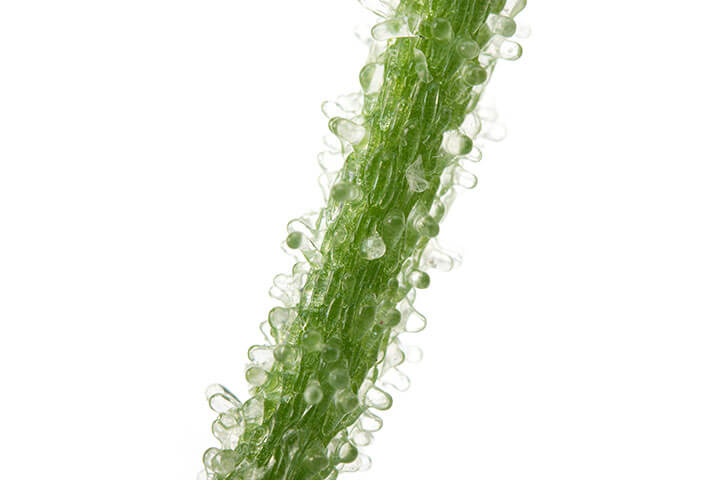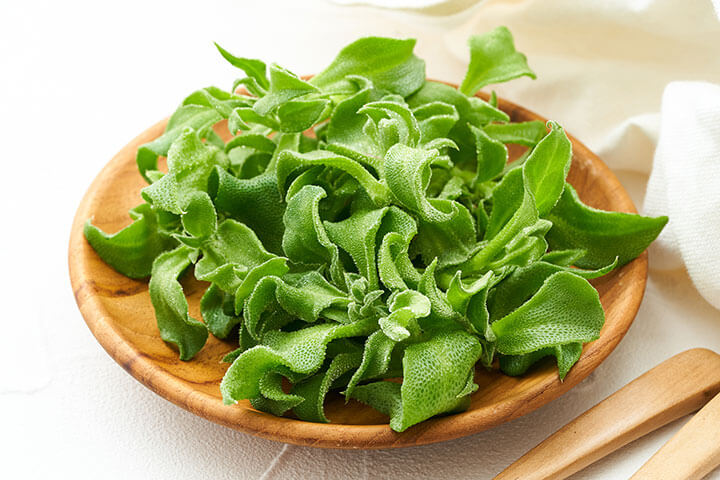Looking for a new ingredient to whet the appetite of your customers? Consider adding the exotic crystalline iceplant to your menu.

What Are Crystalline Iceplants?
The crystalline iceplant (Mesembryanthemum crystallinum L.) also known as common iceplant and salty iceplant, is a visually enchanting addition to any dish. Native to South Africa, this little succulent purportedly made its way to other continents by hitching rides in ship ballast tanks.
Now, this plant has naturalized in parts of North, Central, and South America as well as Asia, Australia, and Europe. Since they have a high tolerance to drought, the crystalline iceplant is often found in desert regions as well as coastal areas. Ironically, the iceplant will die if exposed to frost.
How Did the Crystalline Iceplant Earn Its Name?
The magic of the crystalline iceplant is found in the little hairs or trichomes that cover its surface. These water-filled translucent cells resemble dewdrops and their mysterious texture glistens in the sun like tiny ice crystals.

But Can You Eat It?
Not only are the leaves and stem edible, but they are also delicious and nutritious. Like many others within their taxonomy, this plant contains a high water composition and is therefore very low in calories. Along with low-calorie refreshment, the crystalline iceplant is high in vitamins, minerals, and phytochemicals that help the human body combat disease, oxidative stress and inflammation.
How to Incorporate Glimmering Dew Drops Onto Your Menu
The crystalline iceplant works organically when paired with seafood and Asian-inspired dishes because of its subtle saltiness and fresh taste. Its texture is a sensory paradox of both juicy and crunchy, even after cooking. And of course, the bright green hue always elevates a dish, tying all other elements together and adding a dash of vitality.
We recommend experimenting with this versatile ingredient in the following types of beverages and dishes:
- Tea – Steeped as tea, your customers receive the health benefits of easily absorbed vitamins and minerals.
- Salads – Use the stems and leaves in a salad to add a salty fresh crunch that won’t overpower other flavors.
- Stir Fried – Crystalline iceplant retains its crunch in a stir fry and integrates perfectly with East Asian flavors such as sesame oil, garlic, and ginger.
- Sautéed – Lightly sauté to compliment with seafood.
- Deep Fried – Use delicately battered iceplant as vegetable tempura.
- Garnish – Add an interesting textural element to your dish with raw crystalline iceplant garnish or as a pickled garnish.

Can You Grow Crystalline Iceplant in Your Restaurant’s Garden?
If you are lucky enough to have a garden at your restaurant or a dedicated space to grow vegetables and herbs, you may be wondering if crystalline iceplant should be added to the mix. The answer is maybe.
To reiterate, crystalline iceplants require full sun and steadfast warmth. Temperatures ranging between 65°F and 85°F is ideal for this plant. Above all, to successfully grow a fresh bounty you will need an environment free from frost and cold temperatures. Their preferred soil composition, however, presents some flexibility. This plant easily adapts to many types of well-draining soil such as sand, loam, and clay.
However, there is an important factor to keep in mind. Professional gardeners recommend growing the iceplant in large containers or in a dedicated greenhouse. This practice stems from their tendency to overrun entire gardens.
Iceplant Is the New Spinach
Adding crystalline iceplant to your menu is sure to garner interest and attention. Its intriguing name, splendiferous appearance, subtly salty crunch, and juicy freshness invites restaurant owners to consider adding it as an ingredient.




very interesting